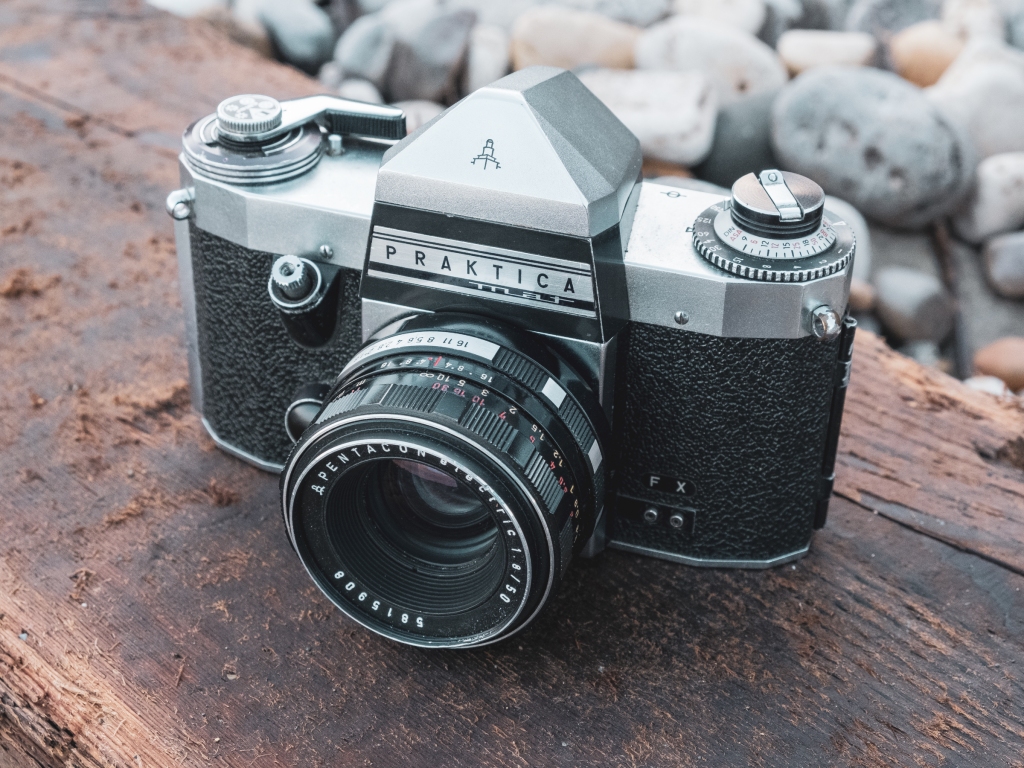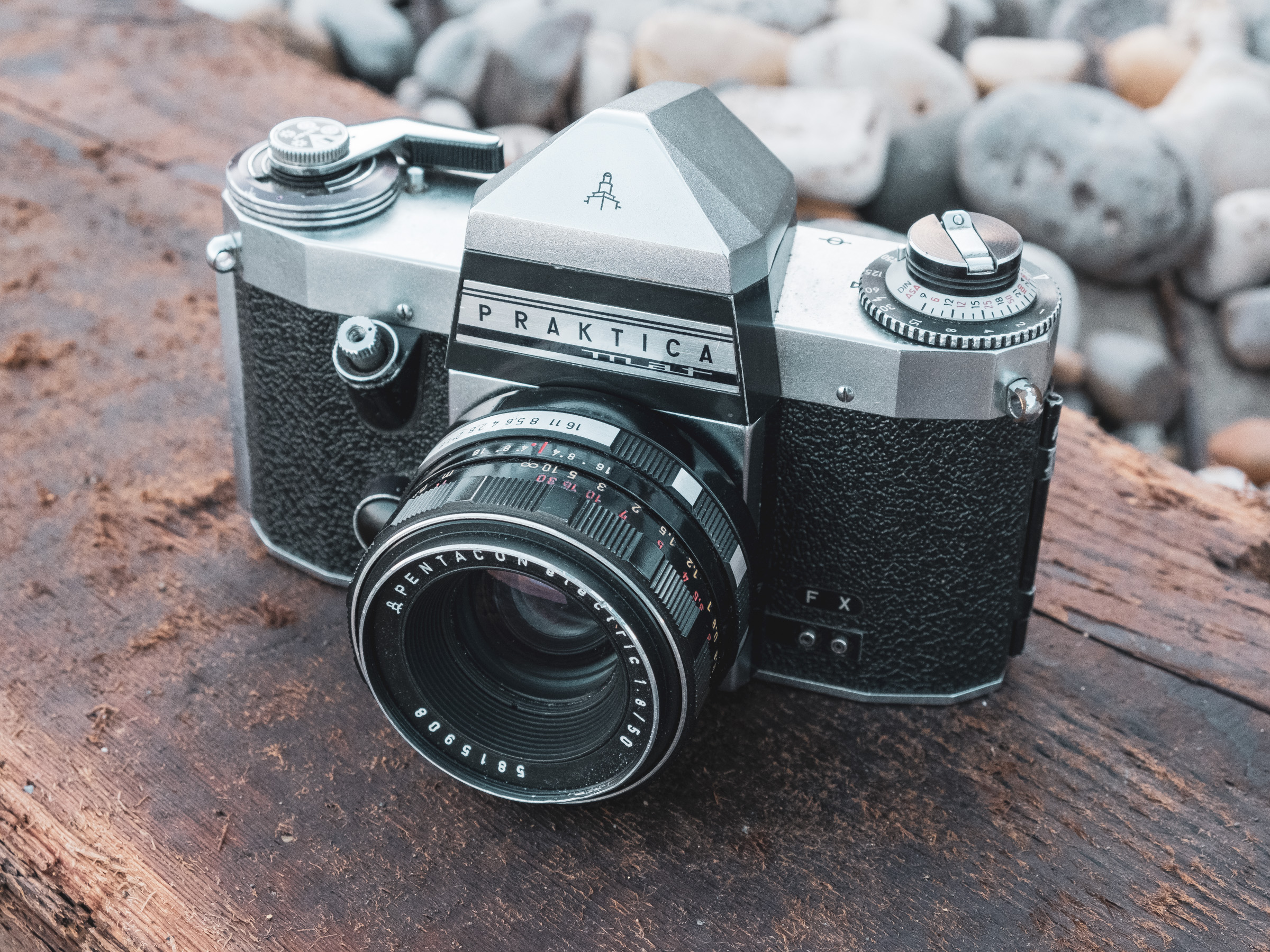Pentacon continues to innovate amidst the rise of the Japanese SLR.

The Praktica Mat is perhaps one of Pentacon’s lesser known models, despite its significance in the development of the SLR. Only 25,000 Mat were made, which was a small run for most Pentacon cameras. I have number 11,666.
Why is the Praktica Mat a Landmark Camera?
1: Europe’s first SLR with TTL metering.
The User Experience
The Look
The Praktica Mat’s sophisticated, advanced metering system utilising a beam splitter in the pentaprism is wrapped in a body that can trace its design back to the early 50’s, and it looks perhaps archaic to some eyes next to the smaller, sleeker Japanese models of the day. I happen to like the way it looks, with its large prism hump, leatherette covering the base plate as well as the body, and cool silver ISO dial with black and red numbering over a black shutter speed dial with silver numbering. The slightly later Pentacon Electric 50mm f/1.8 fitted to the camera matches the design well with its black and silver aperture dial.

The Feel
I like handling this camera. I find it difficult to explain why, but it just feels good in the hand. Is it the chunkiness of the body and the way the shutter release is in the perfect place on the front of the body rather than the top plate? Is it the slightly coarse but grippy leatherette? Maybe it is because I like how it looks?

In Use
This is a great camera in use. I enjoyed using it immensely. The TTL stop-down metering is activated with a simple push of the large, round depth of field preview button below the shutter release, or by half pressing the shutter release itself. You achieve correct exposure by twisting the lens aperture ring and somewhat clunky shutter speed dial until the match needle sits in the middle of a yellow box on the right of the finder.


The viewfinder is slightly dimmer than contemporary finders, due to the beam splitter redirecting some light. However, the excellent Fresnel screen and a superb and very large split image focusing aid more than compensate. The shutter release is lockable. The film rewind release button is very conveniently placed for you right next to the film advance lever. The cherry on the cake of this camera is the shutter itself. It is mercifully quieter than later metal bladed Prakticas, with a lower pitch than many cameras. It feels classy, which made it all the more surprising to find out that the Nova series of cameras on which the Mat is derived had a bad reputation for failing shutters.

Film test
I put a roll of T-MAX 400 in this beauty and took it for a walk around Easington colliery and beach. Unfortunately, it quickly became apparent that the film was not advancing correctly. After 5 exposures, the increasingly stiffening film advance ground to a halt. I deployed the rewind release button to free it up. Back home I opened the back of the camera in a change bag to see if the film had advanced at all. Indeed it had, but had managed to wrap itself around the transport sprocket instead of the take up spool! I reloaded the film and the same thing happened. I’m not sure what’s going wrong at present, but I have moved the roll of film to another camera until I have investigated. I am not giving up on this East German baby. The aesthetic-usability effect has a hold on me!
FURTHER READING:
Praktica Collector
Camera Wiki
Instruction manual at Mike Butkus’ site

A few days before i purchased a Praktica Mat, she will arrive at the end of december, and i’m very excited if she works !?
Well, I hope the camera is working for you.
I have a Practicamat I bought in the 1960s. Unfortunately, the light meter battery is no longer available in the US because it contained a toxic substance.
The mercury cell is banned everywhere, but fortunately the Praktica Mat isn’t fussy about exact voltage, so alternatives can be used successfully, such as PX625A/LR9.
Unfortunately, the Prakticamat, as with all the Nova derived Prakticas, was too often unreliable. I owned three of them at various times and two suffered failures too expensive to justify repair.
Nice design, pity about the engineering. 🙁
Yes, Andrew. I bought a second one and that stiffed too. Such a shame.
Nice review, very interesting. Currently looking for a working example ! These are my thoughts though. I think when buying one, we need to budget for a complete service, even if it currently works !As you can buy a body from £20 to £30, put aside £60 or so for a service, lots of m42 lenses available, so for £100-120 you could have a serviced working camera, so to be that’s good value if you are going to keep it and use it. It of course does not make sense if you were to selling again as you would loose too much. Lovely camera! They key factor is is the meter working to start with.
Maybe we are just expecting too much? Expecting a camera that is 50 to 60 years old or so, that has been sat in a drawer unused for decades to just suddenly jump up and expose a film as perfectly as it did in 1964 is in reality expecting a miracle! I now look at it this way, buy a camera cheaply that is cosmetically good, but has the usual shutter and stiff lens focus problems, spend some money on it, get it serviced, yes it will cost far more than it is worth on the open market, but why would you want to sell it once it is working perfectly again? Believe me, using an old Praktica that has been properly sorted is a joy !
Another good review by the way, enjoyed the read.
Kind Regards,
Phil Walker
Thanks once again Phil. Yes, I agree with you. I do find myself expecting too much of old, dormant cameras!